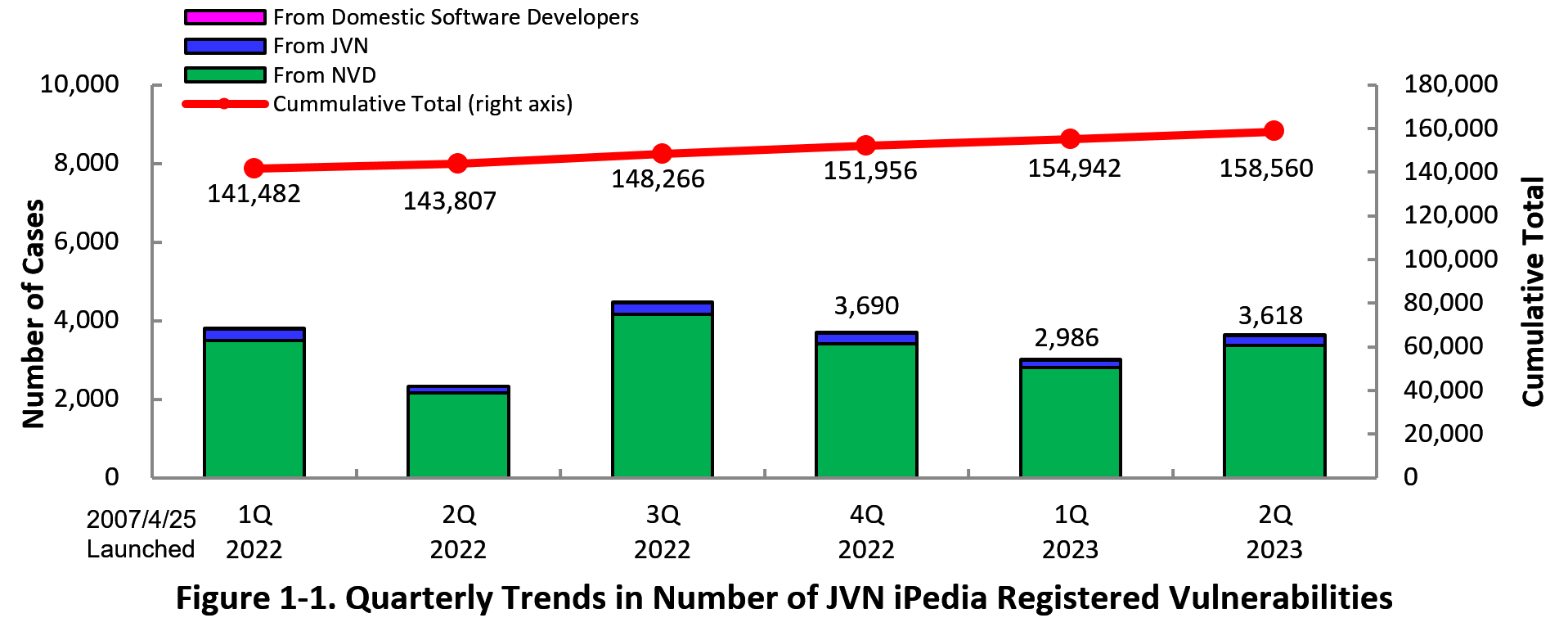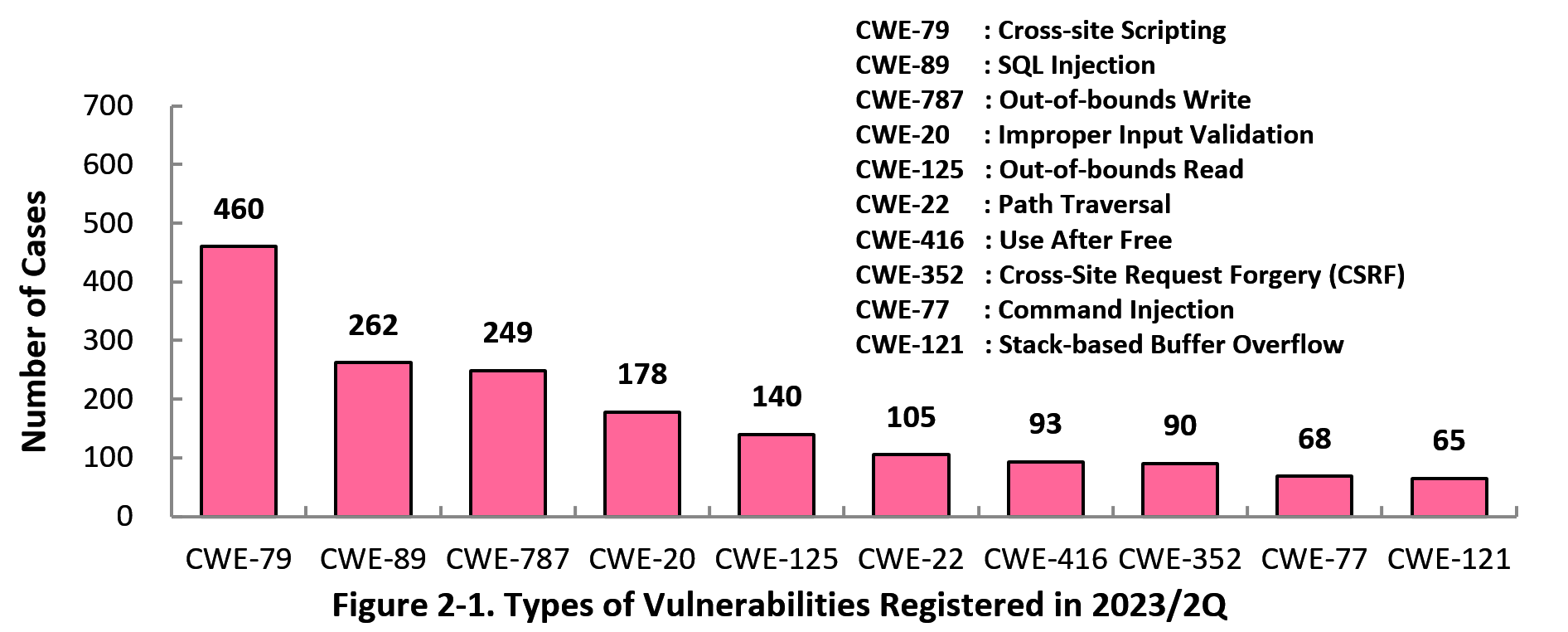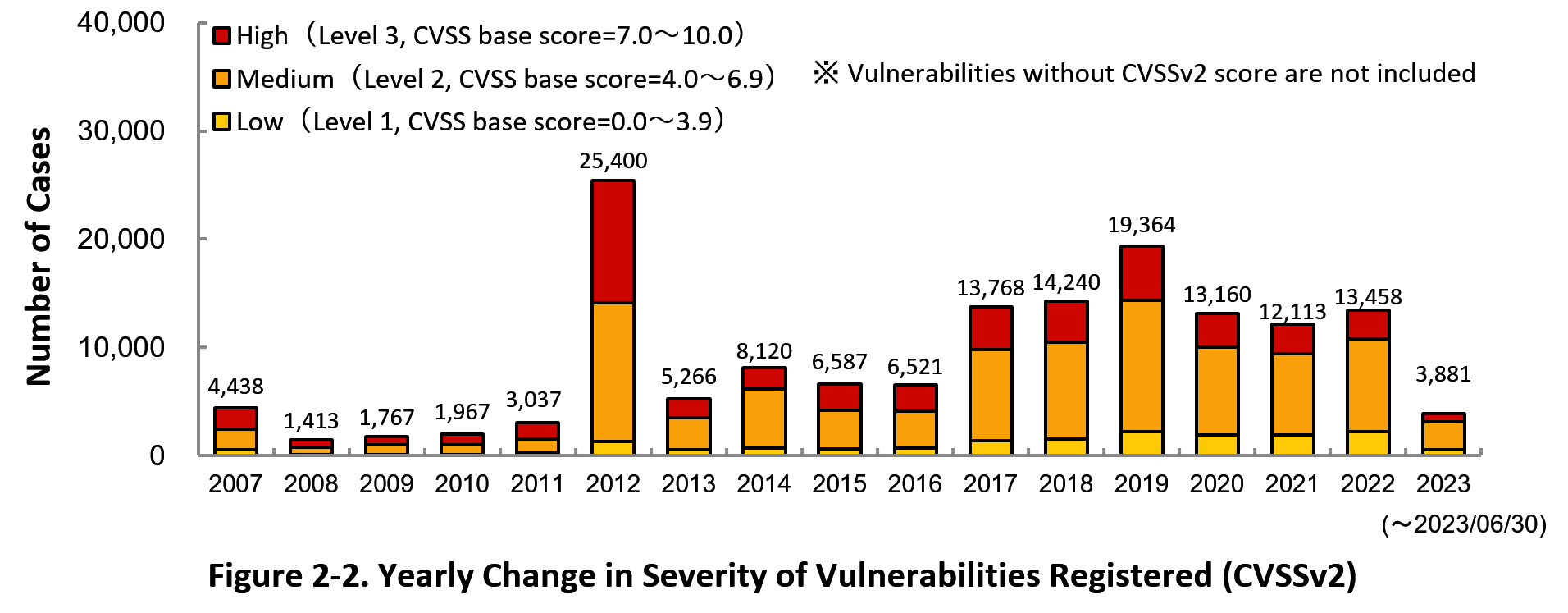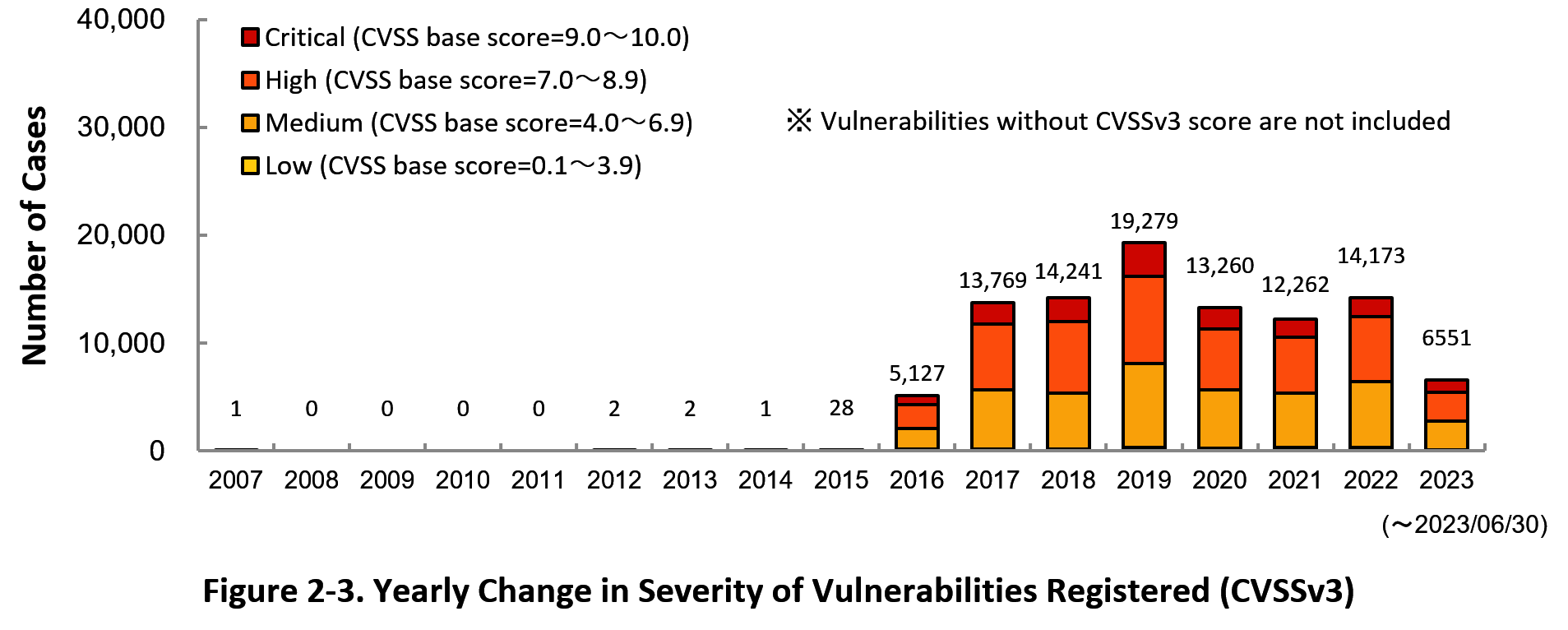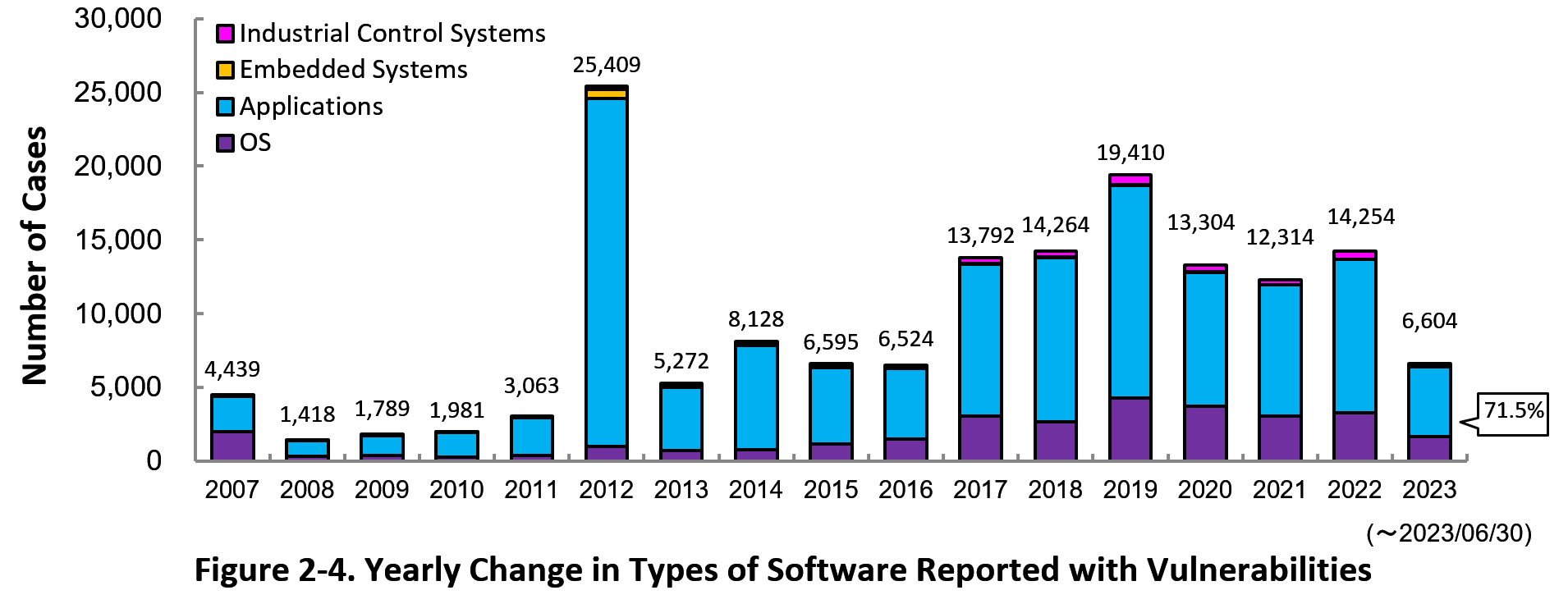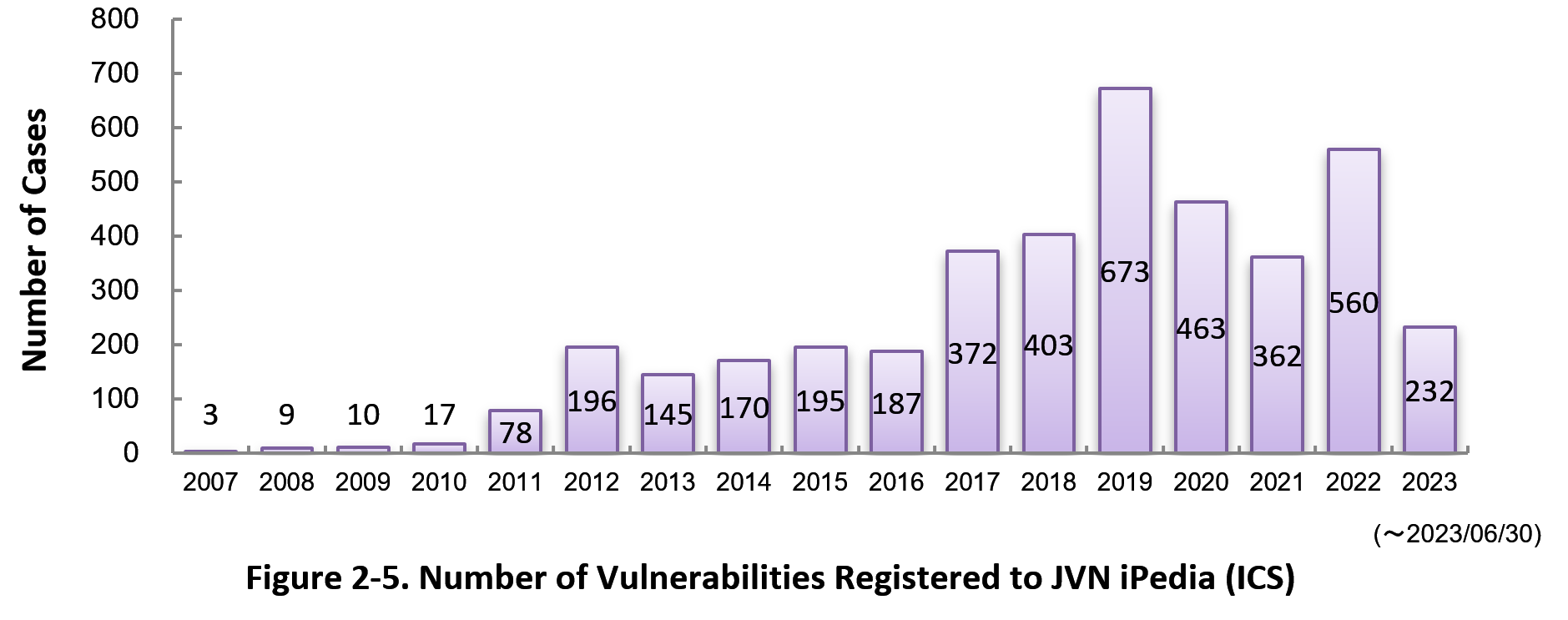Enhancing information security

Vulnerability Countermeasure Information Database JVN iPedia Registration Status [2023 2nd Quarter (Apr. - Jun.)]
Release Date:Aug 23, 2023
IT Security Center
1. 2023 2nd Quarter: Vulnerability Countermeasure Information Database JVN iPedia Registration Status
The vulnerability countermeasure information database JVN iPedia is endeavoring to become a comprehensive vulnerability database where vulnerability information is aggregated for easy access for IT users. JVN iPedia collects and/or translates the vulnerability information published by 1) domestic software developers, 2) JVN (footnote 1), a vulnerability information portal run by JPCERT/CC and IPA, and 3) NVD (footnote 2), a vulnerability database run by NIST (footnote 3). JVN iPedia has been making vulnerability information available to the public since April 25, 2007.
1-1. Vulnerabilities Registered in 2023/2Q
JVN iPedia now stores 158,560 vulnerabilities
The summary of the vulnerability information registered to the Japanese version of JVN iPedia during the 2nd quarter (April 1 to June 30) of 2023 is shown in the table below. As of the end of June 2023, the total number of vulnerabilities stored in JVN iPedia is 158,560 (Table 1-1, Figure 1-1).
As for the JVN iPedia English version, the total number of vulnerabilities stored is 2,629 as shown in the lower half of the Table 1-1.
Table 1-1. Vulnerabilities Registered to JVN iPedia during 2nd Quarter of 2023
|
|
Information Source
|
Registered Cases
|
Cumulative Cases
|
|---|---|---|---|
|
Japanese Version
|
Domestic Software Developers
|
2 cases
|
265 cases
|
|
JVN
|
254 cases
|
12,435 cases
|
|
|
NVD
|
3,362 cases
|
145,860 cases
|
|
|
Total
|
3,618 cases
|
158,560 cases
|
|
|
English Version
|
Domestic Software Developers
|
3 cases
|
269 cases
|
|
JVN
|
54 cases
|
2,360 cases
|
|
|
Total
|
57 cases
|
2,629 cases
|
2. Details on JVN iPedia Registered Data
2-1. Types of Vulnerabilities Reported
Figure 2-1 shows the number of vulnerabilities newly added to JVN iPedia during the 2nd quarter (April to June) of 2023, sorted by the CWE vulnerability types.
The type of the vulnerabilities reported most in the 2nd quarter is CWE-79 (Cross-Site Scripting) with 460 cases, followed by CWE-89 (SQL Injection) with 262, CWE-787 (Out-of-bounds Write) with 249, CWE-20 (Improper Input Validation) with 178, CWE-125 (Out-of-bounds Read) with 140. CWE-79 (Cross-site Scripting), the most reported vulnerability type in this quarter, could allow attackers to display false webpages and/or steal information.
Software developers need to make sure to mitigate vulnerability from the planning and design phase of software development. IPA provides tools and guidelines, such as "Vulnerability Countermeasure Guide for Software Developers" (footnote 4), "How to Secure Your Website" (footnote 5), and "AppGoat" (footnote 6), a hands-on venerability learning tool, for website developers and operators to build secure websites.
2-2. Severity of Vulnerabilities Reported
Figure 2-2 shows the yearly change in the CVSSv2 rating scale based severity of vulnerabilities registered to JVN iPedia.
As for the vulnerabilities added to JVN iPedia in 2023, 20.2 percent are “Level 3” (7.0 - 10.0), 65.7 percent are “Level 2” (4.0 – 6.9) and 14.0 percent are “Level 1” (0.0 – 3.9). This means 85.9 percent of all vulnerabilities registered are Level II or higher, which are potentially critical enough to cause damage like information exposure or data falsification.
Figure 2-3 shows the yearly change in the CVSSv3 rating scale based severity of vulnerabilities registered to JVN iPedia.
As for the vulnerabilities added to JVN iPedia in 2023, 16.8 percent are “Critical” (9.0 – 10.0), 40.5 percent are “High” (7.0 – 8.9), 40.9 percent are “Medium” (4.0 – 6.9) and 1.8 percent are “Low” (0.1 – 3.9).
To avoid threats posed by the known vulnerabilities, both product developers and IT users should pay close attention to vulnerability disclosure and update software they use to a fixed version or apply a security patch as soon as possible when they become available. IT users can check vulnerabilities newly published on JVN iPedia in RSS and XML format (footnote 7) as well.
2-3. Types of Software Reported with Vulnerability
Figure 2-4 shows the yearly change in the type of software reported with vulnerability. Application vulnerabilities have been published most, accounting for 71.5 percent (4,722 out of 6,604) of the 2023 total.
Figure 2-5 shows the yearly change in the number of JVN iPedia-stored vulnerabilities in industrial control systems (ICS) used in critical infrastructure sectors. As of June 2023, the total of 4,075 ICS vulnerabilities have been registered.
2-4. Products Reported with Vulnerability
Table 2-1 lists the top 20 software whose vulnerabilities were most registered to JVN iPedia during the 2nd quarter (April to June) of 2023.
In this quarter, the most registered product was the Qualcomm component. After the second place, Windows OS products provided by Microsoft, Fedora provided by Fedora Project, and OS products, such as Android, provided by Google were on the list.
Besides those in the top 20 list, JVN iPedia stores and offers vulnerability information about a variety of software. IPA hopes software developers and users will make good use of JVN iPedia to efficiently check vulnerability information and take necessary action in a timely manner (footnote 8).
Table 2-1. Top 20 most registered software products vulnerability countermeasure information in JVN iPedia [Apr. – Jun. 2023]
|
Rank
|
Category
|
Product Name (Vendor)
|
Number of
Vulnerabilities Registered |
|---|---|---|---|
|
1
|
Firmware
|
Qualcomm component (Qualcomm) |
420
|
|
2
|
OS
|
Microsoft Windows Server 2022 (Microsoft) |
138
|
|
3
|
OS
|
Microsoft Windows Server 2019 (Microsoft) |
135
|
|
4
|
OS
|
Fedora (Fedora Project) |
134
|
|
5
|
OS
|
Microsoft Windows Server 2016 (Microsoft) |
126
|
|
6
|
OS
|
Microsoft Windows 11 (Microsoft) |
124
|
|
7
|
OS
|
Microsoft Windows 10 (Microsoft) |
119
|
|
8
|
OS
|
Android (Google) |
116
|
|
9
|
OS
|
Microsoft Windows Server 2012 (Microsoft) |
115
|
|
10
|
OS
|
Debian GNU/Linux (Debian) |
109
|
|
11
|
OS
|
Microsoft Windows Server 2008 (Microsoft) |
85
|
|
12
|
Others
|
Insteon Hub (Insteon) |
81
|
|
13
|
Others
|
Bentley View (Bentley Systems) |
80
|
|
14
|
Firmware
|
RLC-410w Firmware (Reolink Digital Technology) |
78
|
|
14
|
Others
|
MicroStation (Bentley Systems) |
78
|
|
16
|
Others
|
MicroStation Connect (Bentley Systems) |
71
|
|
17
|
Browser
|
Google Chrome (Google) |
64
|
|
18
|
Others
|
Google TensorFlow (Google) |
56
|
|
19
|
OS
|
Linux Kernel (Linux) |
44
|
|
20
|
PDF Viewer/Editor
|
PDF-XChange Editor (Tracker Software Products) |
37
|
3. Most Accessed Vulnerability Countermeasure Information
Table 3-1 lists the top 20 most accessed vulnerability countermeasure information in JVN iPedia during the 2nd quarter (April to June) of 2023.
This quarter, as in the previous quarter, many vulnerabilities in plugins for WordPress were ranked. Vulnerabilities released in 2022 were ranked at the top of the list, but this is due to the mechanical access from specific organizations.
Table 3-1. Top 20 Most Accessed Vulnerability Countermeasure Information in JVN iPedia [Apr. – Jun. 2023]
|
Rank
|
ID/Title
|
CVSSv2
Base Score
|
CVSSv3
Base Score
|
Publication Date
|
Access Count |
|---|---|---|---|---|---|
|
1
|
JVNDB-2021-015177 |
7.5
|
9.8
|
2022/11/11
|
10,944
|
|
2
|
JVNDB-2021-015181
iPack SCADA Automation software vulnerable to SQL injection (in Japanese only)
|
7.5
|
9.8
|
2022/11/11
|
10,700
|
|
3
|
JVNDB-2021-015197
Improper authentication vulnerability in Apache ShenYu Admin (in Japanese only)
|
7.5
|
9.8
|
2022/11/11
|
10,288
|
|
4
|
JVNDB-2021-015198
MedData HBYS software vulnerable to SQL injec-tion (in Japanese only)
|
7.5
|
9.8
|
2022/11/11
|
9,594
|
|
5
|
JVNDB-2022-002693
|
-
|
9.8
|
2022/11/11
|
8,815
|
|
6
|
JVNDB-2022-002694
|
-
|
9.8
|
2022/11/11
|
7,934
|
|
7
|
JVNDB-2023-000039
|
2.6
|
4.3
|
2023/4/19
|
7,875
|
|
8
|
JVNDB-2022-002695
Classic buffer overflow vulnerability in CLUS-TERPRO X and EXPRESSCLUSTER X (in Japanese only)
|
-
|
9.8
|
2022/11/11
|
7,400
|
|
9
|
JVNDB-2022-000091
|
5.0
|
5.3
|
2022/11/18
|
7,378
|
|
10
|
JVNDB-2023-000007 |
5.0
|
7.5
|
2023/1/17
|
7,316
|
|
11
|
JVNDB-2023-000040
|
2.6
|
6.1
|
2023/4/24
|
7,233
|
|
12
|
JVNDB-2022-000087
|
5.0
|
5.3
|
2022/11/8
|
7,128
|
|
13
|
JVNDB-2022-000085
|
2.6
|
6.1
|
2022/11/8
|
6,851
|
|
14
|
JVNDB-2022-000038
|
2.6
|
6.1
|
2022/5/24
|
6,791
|
|
15
|
JVNDB-2022-000041
|
4.0
|
5.4
|
2022/6/1
|
6,790
|
|
16
|
JVNDB-2023-000050
|
7.5
|
8.3
|
2023/5/15
|
6,760
|
|
17
|
JVNDB-2023-000042
|
2.6
|
6.1
|
2023/5/9
|
6,405
|
|
18
|
JVNDB-2022-002696
Path traversal vulnerability in CLUSTERPRO X and EXPRESSCLUSTER X (in Japanese only)
|
-
|
9.8
|
2022/11/11
|
6,379
|
|
19
|
JVNDB-2022-000057
|
2.6
|
6.1
|
2022/7/25
|
6,253
|
|
20
|
JVNDB-2022-000026
|
2.6
|
4.3
|
2022/4/15
|
6,163
|
Table 3-2 lists the top 5 most accessed vulnerability information among those reported by domestic software developers.
Table 3-2. Top 5 Most Accessed Vulnerabilities Reported by Domestic Product Developers [Apr. - Jun. 2023]
|
Rank
|
ID/Title
|
CVSSv2
Base Score
|
CVSSv3
Base Score
|
Publication Date
|
Access Count |
|---|---|---|---|---|---|
|
1
|
JVNDB-2023-001492
|
-
|
7.1
|
2023/4/12
|
4,685
|
|
2
|
JVNDB-2023-001926
|
-
|
7.6
|
2023/5/23
|
3,359
|
|
3
|
JVNDB-2023-001008
|
-
|
6.6
|
2023/1/18
|
2,814
|
|
4
|
-
|
6.6
|
2023/3/1
|
2,787
|
|
|
5
|
JVNDB-2022-002771
|
-
|
3.3
|
2022/12/7
|
2,721
|
Footnotes
(1) Japan Vulnerability Notes: A portal for vulnerability countermeasure information including information on vendor response to the reported vulnerabilities and security support. Operated in the collaboration of IPA and JPCERT/CC.
(2) National Vulnerability Database: A vulnerability database operated by NIST.
(3) National Institute of Standards and Technology: A U.S federal agency that develops and promotes measurement, standards and technology.
(4) Vulnerability Countermeasure Guide for Software Developers (in Japanese only)
(5) How to Secure Your Websites (latest version in Japanese only)
(6) AppGoat (in Japanese only)
(7) IPA Data Feeds (in Japanese only)
(8) IPA Technical Watch - Daily Practice Guide (in Japanese only): Tips on Vulnerability Management The guide gives tips on how to efficiently and efficiently collect and leverage vulnerability information.
Past Quarterly Reports
Contact information
IT Security Center,
Information-technology Promotion Agency, Japan (ISEC/IPA)

